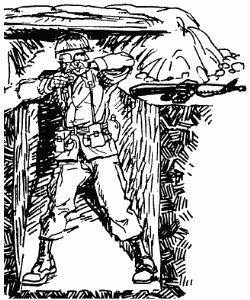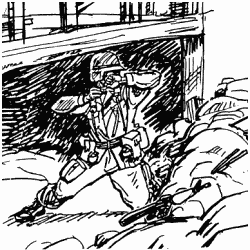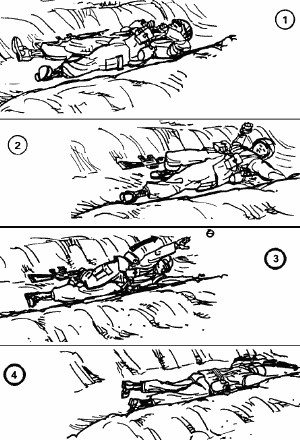GRIPPING PROCEDURES
The importance of properly gripping the hand grenade cannot be overemphasized. Soldiers must understand that a grenade not held
properly is difficult to arm. Gripping procedures differ slightly for right- and left-handed soldiers.
Right-handed soldiers hold the grenade upright with the pull ring away from the palm of the throwing hand so that the pull ring
can be easily removed by the index or middle finger of the free hand.
Left-handed soldiers invert the grenade with the fingers and thumb of the throwing hand positioned in the same manner as by right-handed personnel.
THROWING

Since few soldiers throw in the same manner, it is difficult to establish firm rules or techniques for throwing hand grenades.
How accurately they are thrown is more important than how they are thrown. If a soldier can achieve more distance and accuracy
using his own personal style, he should be allowed to do so as long as his body is facing sideways, towards the enemy's position,
and he throws basically overhand. There is, however, a recommended method of throwing hand grenades:
- Observe the target to mentally establish the distance between your throwing position and the target area.
In observing the target, minimize your exposure time to the enemy (no more than 3 seconds).
- Remove the safety clip.
- Grip the hand grenade in your throwing hand.
- Grasp the pull ring with the index or middle finger of your nonthrowing hand. Remove the safety pin with a pulling and
twisting motion. If the tactical situation permits, observe the safety pin's removal.
- Look at the target and throw the grenade using the overhand method so that the grenade arcs, landing on or near the target.
- Allow the motion of your throwing arm to continue naturally once you release the grenade. This follow-through improves distance
and accuracy and lessens the strain on your throwing arm.
- Practice the necessary throws that are used in combat, such as the underhand and sidearm throws. Soldiers can practice these
throws with practice grenades, but they must throw live fragmentation grenades overhand in a training environment.
THROWING POSITIONS
-
Standing. The standing position is the most desirable and natural position from which to throw grenades.
It allows you to obtain the greatest possible throwing distance. Soldiers normally use this position when occupying a fighting
position or during operations in fortified positions or urban terrain.
- Observe the target to mentally estimate the distance. Use the proper handgrip and arm the grenade while behind cover.
- Assume a natural stance with your weight balanced equally on both feet. Hold the grenade shoulder high and hold the
nonthrowing hand at a 45° angle with the fingers and thumb extended, joined, and pointing toward the intended target.
- Throw the grenade with a natural motion, using the procedures described above in THROWING.
- Seek cover to avoid being hit by fragments or direct enemy fire. If no cover is available, drop to the prone position with
your Kevlar facing the direction of the grenade's detonation.
-
Kneeling. The kneeling position reduces the distance a soldier can throw a grenade. It is used primarily
when a soldier has only a low wall, a shallow ditch, or similar cover to protect him.
- Observe the target to mentally estimate the throwing distance. Using the proper grip, arm the grenade while behind cover.
- Hold the grenade shoulder high and bend your nonthrowing knee at a 90° angle, placing that knee on the ground. Keep
your throwing leg straight and locked, with the side of your boot firmly on the ground. Move your body to face sideways toward
the target position. Keep your nonthrowing hand at a 45° angle with your fingers and thumb extended, joined, and pointing
toward the enemy position.
- Throw the grenade with a natural throwing motion. Push off with your throwing foot to give added force to your throw. Follow
through with your throwing arm.
- Drop to the prone position or behind available cover to reduce exposure to fragmentation and direct enemy fire.
-
Alternate prone. The alternate prone position reduces both distance and accuracy. It is used only when an individual is
pinned down by hostile fire and is unable to rise to engage his target. Use the following procedures when throwing from this position:
- Lie down on your back with your body parallel to the grenade's intended line of flight. Hold the grenade at chin-chest level
and remove the safety pins.
- Cock your throwing leg at a 45° angle, maintaining knee-to-knee contact and bracing the side of your boot firmly on the
ground. Hold the grenade 4 to 6 inches behind your ear with your arm cocked for throwing.
- With your free hand, grasp any object that is capable of giving added leverage to increase your throwing distance. In
throwing the grenade, push off with your rearward foot to give added force to your throw. Do not lift your head or body when
attempting to throw a grenade as this exposes you to direct enemy fire.
- After throwing the grenade, roll over onto your stomach and press flat against the ground.
WEAPON CAPABILITIES
Hand grenades are used extensively during combat in urban areas. Smoke grenades are used for obscuration and signaling. Riot control
grenades are used to control civil disturbances. Fragmentation, concussion and stun grenades are used to clear the enemy from rooms
and basements. Hand grenades are the most used explosive munition during intense combat in urban areas. In World War II, it was common
for a battalion fighting in a city to use over 500 fragmentation grenades each day. Stun grenades are used primarily during precision
clearing of an urban structure when the presence of noncombatants is likely.
Hand grenades are difficult weapons to use. They involve a high risk of fratricide. Commanders should conduct precombat training
with hand grenades as part of normal preparations. Soldiers must be very careful when throwing hand grenades.
Offensive Grenades
The MK3A2 offensive hand grenade, commonly referred to as the concussion grenade, produces casualties during close combat while
minimizing the danger to friendly personnel. The grenade produces severe concussion effects in enclosed areas. For this reason,
it is the preferred hand grenade during offensive operations in a MOUT (military operations on urbanized terrain) environment.
It can be used for light blasting and demolitions, and for creating breach holes in interior walls. The concussion produced by the
MK3A2 is much greater than that of the fragmentation grenade. It is very effective against enemy soldiers in bunkers, buildings,
and underground passages.
Smoke Grenades
The effects of smoke grenades in urban areas are nominal. Smoke grenades produce dense clouds of colored or white smoke that remain
stationary in the surrounding area. They can cause fires if used indiscriminately. If trapped and concentrated within a small space,
their smoke can suffocate soldiers.
Smoke hand grenades produce either white smoke or colored smoke for short periods of time. Because they only produce small amounts
of smoke, smoke hand grenades are not effective for screening units larger than one or two squads. White smoke grenades are most
often used to conceal individual vehicles; colored smoke grenades are used to mark or spot positions.
The AN-M8 HC smoke grenade produces a dense white or gray smoke. It burns intensely and cannot be easily extinguished once it ignites.
The smoke can be dangerous in heavy concentrations because it makes breathing difficult and causes choking. The M8 grenade is normally
used for screening. It produces a slowly building screen of longer duration than the obsolete M34 WP grenade without the problem of
collateral damage caused by scattered burning particles.
Incendiary Grenades
The AN-M14 TH3 incendiary hand grenade is used to destroy equipment and start fires. It is used to damage, immobilize, or destroy
vehicles, weapons systems, shelters, and ammunition. The M14 incendiary grenade is especially effective against flammable objects
such as wooden structures. It is also used to create an immediate smoke cloud to conceal movement across a narrow open space such
as a street. Its smoke is not toxic but can cause choking in heavy concentrations.
The AN-M14 incendiary grenade is an effective weapon against enemy armored vehicles when used in the close confines of combat in
urban areas. It can be thrown or dropped from upper stories onto enemy vehicles.
Riot Control Grenades
The M7A3 CS riot control grenade can be used to control riots or disperse personnel. Urban areas often create variable and shifting
wind patterns. When using CS grenades, soldiers must prevent the irritating smoke from affecting friendly troops. The CS grenade
burns intensely and can ignite flammable structures. Enemy troops wearing even rudimentary chemical protective masks can withstand
intense concentrations of CS gas.
Fragmentation Grenades
The fragmentation grenade produces a large amount of small high-velocity fragments, which can penetrate plasterboard partitions and
are lethal at short ranges (15 to 20 meters). Fragments lose their velocity quickly and are less effective beyond 25 meters. The
fragments from a fragmentation grenade cannot penetrate a single layer of sandbags, a cinder block, or a brick building, but they can
perforate wood frame and tin buildings if exploded close to their walls.
Fragmentation barriers consisting of common office furniture, mattresses, doors, or books can be effective against the fragmentation
grenade inside rooms. For this reason, a room should never be considered safe just because one or two grenades have been detonated
inside. Fragmentation grenades detonated on the floor not only throw fragments laterally but also send fragments and spall downward
to lower floors. Predicting how much spall will occur is difficult since flooring material varies, but wooden floors are usually
affected the most.
The M67 fragmentation grenade is the most commonly available grenade during combat in urban areas. It provides suppression during
room-to-room or house-to-house fighting, and is used while clearing rooms of enemy personnel. When used at close ranges, it can be
cooked off for two seconds to deny the enemy time to throw it back. The fragmentation grenade can be rolled, bounced, or ricocheted
into areas that cannot be reached by 40mm grenade launchers. Soldiers must be cautious when throwing grenades up stairs. This is
not the most desired method of employment.
A major problem with the US-made fragmentation grenade is its tendency to bounce back off hard targets. Grenades are often directed
at window openings on the ground floor or second floor. At ranges as close as 20 meters, a thrower's chances of missing a standard
1-meter by 1-meter window are high. The fragmentation grenade normally breaks through standard window glass and enters a room.
If the grenade strikes at a sharp angle or the glass is thick plate, the grenade could be deflected without penetrating.
Stun Grenades
The M84 stun hand grenade is designed to be thrown into a room (through an open door, a standard glass window, or other opening)
to deliver a loud bang and bright flash sufficient enough to temporarily disorient personnel in the room.
More Grenade Art
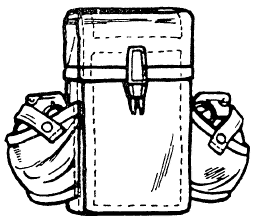
Ammo pouch with grenades
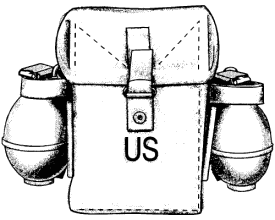
Ammo pouch with grenades




 Since few soldiers throw in the same manner, it is difficult to establish firm rules or techniques for throwing hand grenades.
How accurately they are thrown is more important than how they are thrown. If a soldier can achieve more distance and accuracy
using his own personal style, he should be allowed to do so as long as his body is facing sideways, towards the enemy's position,
and he throws basically overhand. There is, however, a recommended method of throwing hand grenades:
Since few soldiers throw in the same manner, it is difficult to establish firm rules or techniques for throwing hand grenades.
How accurately they are thrown is more important than how they are thrown. If a soldier can achieve more distance and accuracy
using his own personal style, he should be allowed to do so as long as his body is facing sideways, towards the enemy's position,
and he throws basically overhand. There is, however, a recommended method of throwing hand grenades:
